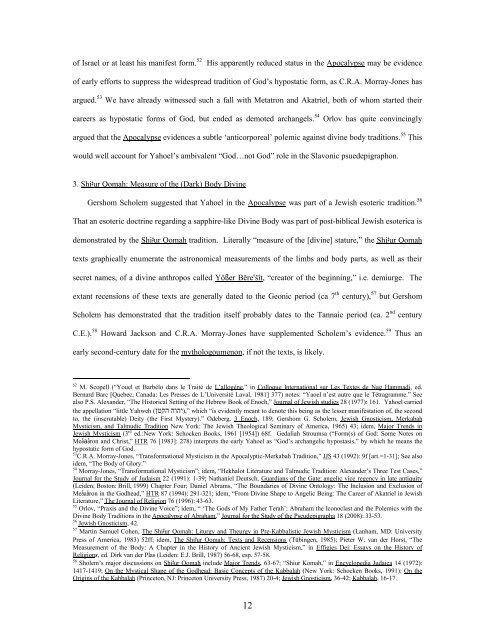Sapphiric God: - Dr. Wesley Muhammad
Sapphiric God: - Dr. Wesley Muhammad
Sapphiric God: - Dr. Wesley Muhammad
You also want an ePaper? Increase the reach of your titles
YUMPU automatically turns print PDFs into web optimized ePapers that Google loves.
of Israel or at least his manifest form. 52 His apparently reduced status in the Apocalypse may be evidence<br />
of early efforts to suppress the widespread tradition of <strong>God</strong>’s hypostatic form, as C.R.A. Morray-Jones has<br />
argued. 53 We have already witnessed such a fall with Metatron and Akatriel, both of whom started their<br />
careers as hypostatic forms of <strong>God</strong>, but ended as demoted archangels. 54 Orlov has quite convincingly<br />
argued that the Apocalypse evidences a subtle ‘anticorporeal’ polemic against divine body traditions. 55 This<br />
would well account for Yahoel’s ambivalent “<strong>God</strong>…not <strong>God</strong>” role in the Slavonic psuedepigraphon.<br />
3. Shi#ur Qomah: Measure of the (Dark) Body Divine<br />
Gershom Scholem suggested that Yahoel in the Apocalypse was part of a Jewish esoteric tradition. 56<br />
That an esoteric doctrine regarding a sapphire-like Divine Body was part of post-biblical Jewish esoterica is<br />
demonstrated by the Shi#ur Qomah tradition. Literally “measure of the [divine] stature,” the Shi#ur Qomah<br />
texts graphically enumerate the astronomical measurements of the limbs and body parts, as well as their<br />
secret names, of a divine anthropos called Yôßer Bĕre"šît, “creator of the beginning,” i.e. demiurge. The<br />
extant recensions of these texts are generally dated to the Geonic period (ca 7 th century), 57 but Gershom<br />
Scholem has demonstrated that the tradition itself probably dates to the Tannaic period (ca. 2 nd century<br />
C.E.). 58 Howard Jackson and C.R.A. Morray-Jones have supplemented Scholem’s evidence. 59 Thus an<br />
early second-century date for the mythologoumenon, if not the texts, is likely.<br />
52<br />
M. Scopell (“Youel et Barbélo dans le Traité de L’allogène,” in Colloque International sur Les Textes de Nag Hammadi, ed.<br />
Bernard Barc [Quebec, Canada: Les Presses de L’Université Laval, 1981] 377) notes: “Yaoel n’est autre que le Tétragramme.” See<br />
also P.S. Alexander, “The Historical Setting of the Hebrew Book of Enoch,” Journal of Jewish studies 28 (1977): 161. Yahoel carried<br />
the appellation “little Yahweh (ןטקה הוהי),” which “is evidently meant to denote this being as the lesser manifestation of, the second<br />
to, the (inscrutable) Deity (the First Mystery).” Odeberg, 3 Enoch, 189; Gershom G. Scholem, Jewish Gnosticism, Merkabah<br />
Mysticism, and Talmudic Tradition New York: The Jewish Theological Seminary of America, 1965) 43; idem, Major Trends in<br />
Jewish Mysticism (3 rd ed.:New York: Schocken Books, 1961 [1954]) 68f. Gedaliah Stroumsa (“Form(s) of <strong>God</strong>: Some Notes on<br />
Meãaãron and Christ,” HTR 76 [1983]: 278) interprets the early Yahoel as “<strong>God</strong>’s archangelic hypostasis,” by which he means the<br />
hypostatic form of <strong>God</strong>.<br />
53<br />
C.R.A. Morray-Jones, “Transformational Mysticism in the Apocalyptic-Merkabah Tradition,” JJS 43 (1992): 9f [art.=1-31]; See also<br />
idem, “The Body of Glory.”<br />
54<br />
Morray-Jones, “Transformational Mysticism”; idem, “Hekhalot Literature and Talmudic Tradition: Alexander’s Three Test Cases,”<br />
Journal for the Study of Judaism 22 (1991): 1-39; Nathaniel Deutsch, Guardians of the Gate: angelic vice regency in late antiquity<br />
(Leiden; Boston: Brill, 1999) Chapter Four; Daniel Abrams, “The Boundaries of Divine Ontology: The Inclusion and Exclusion of<br />
Meãaãron in the <strong>God</strong>head,” HTR 87 (1994): 291-321; idem, “From Divine Shape to Angelic Being: The Career of Akatriel in Jewish<br />
Literature,” The Journal of Religion 76 (1996): 43-63.<br />
55<br />
Orlov, “Praxis and the Divine Voice”; idem, “ ‘The <strong>God</strong>s of My Father Terah’: Abraham the Iconoclast and the Polemics with the<br />
Divine Body Traditions in the Apocalypse of Abraham,” Journal for the Study of the Pseudepigrapha 18 (2008): 33-53.<br />
56<br />
Jewish Gnosticism, 42.<br />
57<br />
Martin Samuel Cohen, The Shi#ur Qomah: Liturgy and Theurgy in Pre-Kabbalistic Jewish Mysticism (Lanham, MD: University<br />
Press of America, 1983) 52ff; idem, The Shi#ur Qomah: Texts and Recensions (Tübingen, 1985); Pieter W. van der Horst, “The<br />
Measurement of the Body: A Chapter in the History of Ancient Jewish Mysticism,” in Effigies Dei: Essays on the History of<br />
Religions, ed. Dirk van der Plas (Leiden: E.J. Brill, 1987) 56-68, esp. 57-58.<br />
58<br />
Sholem’s major discussions on Shi#ur Qomah include Major Trends, 63-67; “Shiur Komah,” in Encyclopedia Judaica 14 (1972):<br />
1417-1419; On the Mystical Shape of the <strong>God</strong>head: Basic Concepts of the Kabbalah (New York: Schocken Books, 1991); On the<br />
Origins of the Kabbalah (Princeton, NJ: Princeton University Press, 1987) 20-4; Jewish Gnosticism, 36-42; Kabbalah, 16-17.<br />
12
















